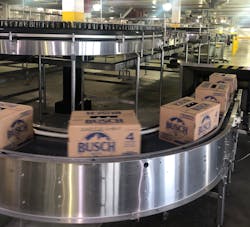I recently visited the Anheuser-Busch headquarters in St. Louis for a plant tour, a visit with the world-famous Budweiser Clydesdales, a tutorial on the brewing process, and, of course, some taste testing of the many varieties of beer made on site. I was also able to sit down with Ken VonderHaar, the global director of the Can Division at Anheuser-Busch InBev (AB InBev), to discuss some of the innovations happening within his group. And, not surprisingly, the primary focus these days is on flexibility around the different types of packaging—especially with the addition of seltzers and variety packs in the product portfolio.
Cans (vs. bottles) is the biggest area of growth moving forward, due in large part to the pandemic and people taking 30 packs of beer home instead of going out to the bars and restaurants. That trend seems to continue. And just as consumers are bringing activities “in-house,” there’s also a trend in manufacturing to do the same.
Anheuser-Busch has both can-making and bottle-making capabilities in its vertical operations, which was established in the early 1970s primarily as way to control cost and product quality. And it’s come in handy given supply chain woes of late.
“Our vertical operations not only give us surety of supply for some of the commodities that are in tight supply, like a can or a bottle right now, but more importantly, it gives us the ability to manage our contract costs when we buy from other folks,” VonderHaar explained. “So the whole business model of vertical operations is not to grow that as fast as the beer company grows. It's to grow that with enough critical mass such that the other suppliers would say, hey, I need to be cost competitive on this otherwise Anheuser-Busch will build their own.”
And, having over 150 years of business under its belt and being nimble enough to adapt to every curve ball—including 13 years of Prohibition in which the company switched to making the Bevo soft drink—clearly the company is not afraid to innovate on its own.
“In the next year or so, you will see us introducing a completely new package for a machine that was developed in house by Anheuser-Busch,” VonderHaar said, noting that it will be introduced into the market as a solution for secondary packaging of bottles.
Of course, Anheuser-Busch can’t make every machine on its own, and with evolving needs around sustainability and energy-efficiency, it’s turning to machine builders and automation suppliers for help, said VonderHaar. “We absolutely need our equipment suppliers to come in and help us figure out how to minimize compressed air usage, reduce gas usage, and reduce energy and electricity usage.”
He'd also be willing to give machine builders more remote access, but noted it’s a continuous challenge as the IT team will not allow that to happen due to the security risk to operations. However, he feels it is something the company, together with technology partners, must figure out how to do safely as business continues to grow.
But there are other ways technology partners can help now. When new projects are planned, VonderHaar will ask supplier partners to come in early in the process to participate in the planning of how the machines should be made to maximize flexibility while minimizing complexity.
VonderHaar, who has been with the company for 34 years, noted that 40% of the company’s workforce is ready to retire at any time. So, as a new generation of operators hit the factory floor, VonderHaar is asking OEMs to make the machines easy to use. “We’re asking for simplicity. We would like all of the complexity under the hood. And we would like an operator interface that’s very easy to understand. Also, an interface that our younger employees are able to [use] with some type of video screens and setup procedures built into the [HMI] screen.”
Of course, I couldn’t leave without asking VonderHaar what the next big thing will be in Budweiser beverages—which, it turns out, is always tough to call. “The consumer defines the next trend,” he said. “We think that the seltzer market still has more legs to it—more flavors and that type of thing—but our innovations team is constantly working on all kinds of different brands and all kinds of different varieties to try to figure out what the next big thing is going to be. We'll test market that and see what sticks.”


